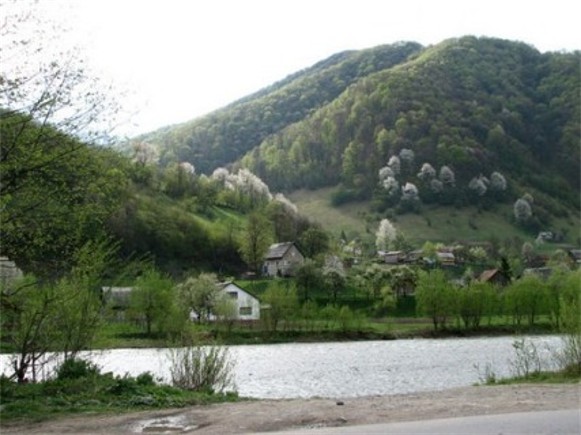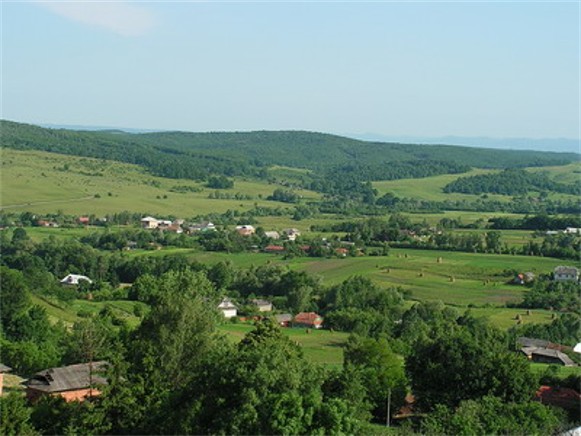Pokutia
Pokutia [Покуття] (Romanian: Pokucia). A historical-geographic upland region bounded by the Dnister River and the Podolian Upland to the north, the Prut River and Subcarpathia to the south, the Stanyslaviv Depression to the west, and the Kitsman Depression and the Sovytsia River to the east. Extending up to 100 km from east to west and 25–40 km from north to south, Pokutia covers about 3,000 sq km and has a population of about 400,000. Users of the Pokutian dialects also inhabit a portion of Subcarpathia. Because of their presence there, the term Pokutia has been used to refer to the entire southeastern corner of Galicia between historic Hungary to the southwest and Moldavia to the southeast. Occasionally the term even included a part of Bukovyna.
Physical geography. Pokutia is the northwestern part of the Pokutian-Bessarabian Upland. Tectonically, it is the southwestern branch of the Ukrainian Crystalline Shield. The old Paleozoic sedimentaries lie far below the Miocene marls, limestones, shales, and gypsum, which in turn are covered by thick layers of loess. At the end of the Tertiary period Pokutia was a flat lowland crossed by the meandering Dnister River. At the end of the Pliocene and the beginning of the Pleistocene epoch an uplift caused the Dnister River and the Prut River to cut deeply into the sediments, thereby setting off subsequent erosion by their tributaries and the dissection of the Prut-Dnister interfluve. At that time a relative downwarping formed the Stanyslaviv Depression and caused the Bystrytsia River to change direction and to flow into the Dnister River instead of the Prut River.
Today Pokutia is a gently undulating plain sloping to the southeast. Elevations range from 300 to 350 m above sea level. In general the western part is more dissected than the eastern part. The landscape is divided into a number of alternating rises and shallow basins. Widespread gypsum deposits account for the abundance of karst features, such as sink holes, dolines, caves, karst lakes, disappearing rivers, and bare gypsum cliffs, particularly in the Tlumach-Horodenka Basin.
The Dnister region, a narrow (10–15 km) band along the right bank of the Dnister River, has a different landscape. It is as deeply dissected as the opposite bank on the Podilia side. In the south the long Kolomyia-Chernivtsi Depression forms a terraced alluvial lowland along the Prut River.
The river network of Pokutia has a radial character. Short rivers flow northward into the Dnister River, longer ones flow southward into the Prut River, and a few join the Bystrytsia River (tributary of the Dnister River) to the west. The network is poorly developed because of the karst landscape. The rivers are short, shallow, and deeply incised in the soft, relatively soluble rock.
The climate of Pokutia is temperate continental: the average annual temperature ranges from 6.9°C to 7.6°C, the average January temperature, from –4.8°C to –5.1°C, and the average July temperature, from 18.2°C to 18.8°C. The number of days with temperatures above 15°C ranges from 96 to 110. Precipitation is adequate to fairly abundant, from 550 to 640 mm per year, depending on the elevation of the region. Soils are mostly podzolized chernozems (with up to 4 percent humus). In western Pokutia there are also gray forest podzolized soils (1–3 percent humus). The natural vegetation is typical of the Central European broad-leaved forest zone and the East European forest-steppe. Very little of Pokutia's original vegetation has survived. The forests have been reduced to barely 10 percent of the land area in western Pokutia and 7 percent in the east. The forests usually consist of hornbeam and oak, and the groves along the rivers, of alder. Remnants of steppe vegetation include wormwood, esparto grass, thistle, and sage.
History. Greek and Roman accounts of widespread Slavic settlement have been confirmed by archeological finds in Pokutia. In the 4th and 5th centuries the Slavs of Pokutia were members of the Antes tribal alliance, in the 6th and 7th centuries, of the Dulibian alliance (see Dulibians), and in the 8th and 9th centuries, of the Tivertsian alliance (see Tivertsians). In the 10th century Pokutia was part of Kyivan Rus’, and after the Liubech congress of princes it became part of the Halych principality. Although it was sparsely settled, there were some towns, such as Sniatyn (known since 1158) and Kolomyia (since 1240), in the region. In the second half of the 14th century Poland annexed Galicia, including Pokutia, which was claimed by the emerging principality of Moldavia. The name Pokutia was first mentioned in 1395 in a Moldavian charter, and again in a 15th-century Polish chronicle by Jan Długosz. In 1388, for a loan of 3,000 gold coins Jagiełło of Poland placed Pokutia under the administration of the Moldavian voivode P. Muşat. Stephen III of Moldavia (1457–1504) led two campaigns to Pokutia (1498, 1502) and pushed the Poles back beyond the Bystrytsia River. His son, Bogdan III (1504–17), disclaimed Pokutia and then occupied it briefly, in 1509–10. Voivode P. Rareş's attempts to recapture Pokutia (1531, 1535) failed. The last Moldavian attempt to seize Pokutia was made by John the Terrible in 1572. The Moldavian-Polish wars caused the local population much suffering. Many Pokutians were captured and resettled in Moldavia and Bukovyna, where they strengthened the Ukrainian element.
Along with western Ukraine Pokutia remained under Polish rule until 1772, when it became part of the Austrian Empire. In the 17th to 19th centuries the Ukrainian opryshoks were active in the region. When the Austrian Empire collapsed, most of Pokutia became part of the Western Ukrainian National Republic (1919). Except for the eastern extremity (east of Sniatyn), which was taken by Romania, Pokutia was occupied by Poland in 1919–39 and then incorporated into Soviet Ukraine. Most of its territory lies in Ivano-Frankivsk oblast. The eastern part lies in Chernivtsi oblast.
Population. Along with Subcarpathia Pokutia belongs to the most densely populated part of Ukraine. The average density approaches 130 people per sq km, and the rural density, 100 people per sq km. The highest densities occur in southern Pokutia along the Prut River. Less than 30 percent of the population is urban. Cities such as Ivano-Frankivsk and Chernivtsi lie outside the region. The Pokutian cities of Kolomyia (2010 pop 70,000), Sniatyn (10,200), and Zabolotiv (4,200) are all located on the Prut River. The former county towns of Horodenka (9,500) and Tlumach (8,600) and the urban-type settlements of Obertyn (3,400), Hvizdets (1,900), and Otynia (5,300) are located in the upland.
At the end of the 18th century Pokutia was inhabited by Ukrainians, who constituted nearly 90 percent of the population, some Jews, and a small number of Poles and Armenians. With time more Poles settled in the region, especially in the 1920s and 1930s. A small number of Germans lived in Kolomyia and its vicinity. In 1939, Ukrainians constituted 74 percent of Pokutia's population, Poles, 9 percent, Ukrainian-speaking Roman Catholics, 7 percent, and Jews, 9 percent. In the 2000s Ukrainians account for 97 percent, Russians, 2 percent, Poles, less than 1 percent, and Jews, 0.2 percent of the population.
Economy. Pokutia was and remains predominantly agricultural. Nearly 76 percent of the land is cultivated, 9 percent is hayfields and pastures, and 9 percent is forest. The sown area is distributed approximately as follows: grains occupy 44 percent, including some 20 percent occupied by wheat, 10 percent by corn, 7 percent by barley, 4 percent by rye, 2 percent by oats, and 1 percent by millet and buckwheat; potatoes and vegetables together take up 15 percent; technical crops another 14 percent, including 10 percent occupied by sugar beets; and feed crops, the remaining 27 percent. The area devoted to corn, sugar beets, and tobacco increases toward the east. Livestock husbandry is concentrated on meat and milk production.
Industry does not play an important role in the region. Only Kolomyia, the largest city, has a broad base of light industries (cotton industry, knitwear industry, clothing industry, curtain-making industry, and footwear industry), food industry (meat-processing industry, dairy industry, flour milling, liquor and spirits distilling), woodworking industry (furniture industry and paper industry), and agricultural machine building. Traditional handicrafts are maintained, such as wood carving, embroidery, and kilim weaving. Other towns have a food industry: sugar refining in Kostryzhivka and dairying (butter, cheese, and milk products) in Horodenka and Sniatyn. The deposits of phosphorites, gypsum, and limestone have not been exploited on a large scale by the chemical industry or building-materials industry.
BIBLIOGRAPHY
Korduba, M. ‘Moldavs’ko-pol’s’ka hranytsia na Pokutiu do smerty Stefana Velykoho,' Naukovyi zbirnyk prysviachenyi profesorovy Mykhailovy Hrushevs’komu (Lviv 1906)
Czyżewski, J.; Koczwara, M.; Zglinicka, A. Pokucie (Lviv 1931)
Kvitkovs’kyi, D.; Bryndzan, T.; Zhukovs’kyi, A. (eds). Bukovyna, ïï mynule i suchasne (Paris–Philadelphia–Detroit 1956)
Koinov, M. Pryroda Stanyslavivs’koï oblasti (Lviv 1960)
Istoriia mist i sil Ukraïns’koï RSR: Ivano-Frankivs’ka oblast’ (Kyiv 1971)
Volodymyr Kubijovyč, M Kovaliuk, Ihor Stebelsky, Arkadii Zhukovsky
[This article originally appeared in the Encyclopedia of Ukraine, vol. 4 (1993).]
This subject is not referenced in any other entries of the Encyclopedia of Ukraine.

